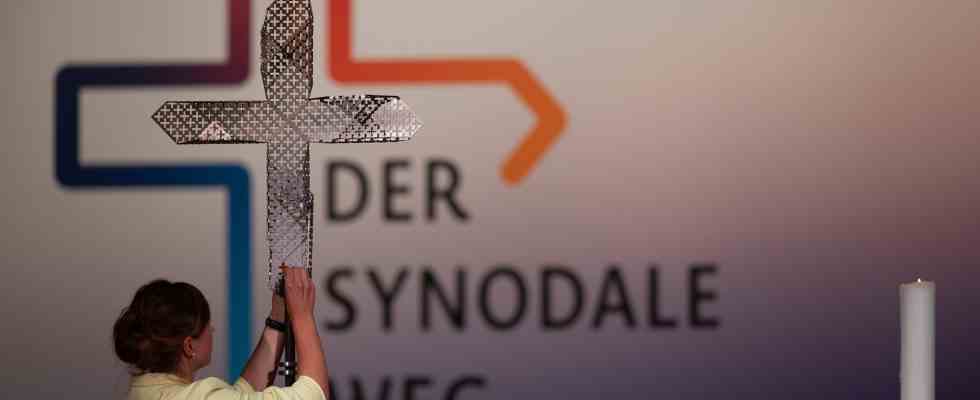Status: 09.03.2023 3:45 p.m
The reform process in the Catholic Church in Germany is on the brink. Do the bishops risk breaking with Rome in the dispute over the “Synodal Path” or do they cave in? There could be a scandal in Frankfurt.
The nervousness is palpable. Even the chairman of the bishops’ conference, Bishop Georg Bätzing, warned of an uproar in view of the fifth plenary assembly of the synodal path, which “I do not wish for any of us”.
The dialogue between lay people and bishops for a reform of the Catholic Church in Germany is entering its final round. Important papers are pending decision in Frankfurt: women should be allowed to preach, homosexual couples should receive a church blessing, Rome should make the ordination of women deacons possible and consider abolishing the mandatory celibacy for priests. Demands that are almost unanimously endorsed by the laity in the “Synodal Way”. But are the bishops staying the course?
Rough wind from Rome
The headwind from Rome has recently increased significantly. All of the demands now under discussion have now been expressly rejected by the Vatican. Will the majority of bishops risk conflict with Rome? Or will they give in, refuse the necessary two-thirds majority of the bishops for the reform papers and thus accept that the “synodal path” will fail?
There are signs that the continuous Roman fire against the “Synodal Way” is having an effect on some officials. When the bishops were in Rome in November for the regular report, the “ad limina visit”, they were confronted with the demand to suspend the “synodal path” immediately. The bishops, led by the conference chairman Bätzing, opposed such a moratorium. But the shock seems to have gotten into the limbs of one or the other.
Catholic power architecture in danger?
The next warning shot followed two months later. This time it was about the “Synodal Council” that was decided last September. That would be a nationwide church management body in which bishops and lay people would advise and make decisions on all relevant issues, including finances. From the Roman point of view, such a body undermines the sole authority of the bishops and thus lays an ax to the root of the Catholic architecture of power.
The three Curia cardinals who announced the ban on the “Synodal Council” on January 16 had previously obtained the backing of the Pope. Bishop Bätzing was steadfast and called the Vatican’s reservations “unfounded”. He assured the cardinals that “the concerns you have raised will be taken seriously” and that everything will conform to canon law.
On a confrontational course – or rather not?
But with this push, Rome presented the General Assembly with another acid test. Because on Saturday the election of 20 members of the “Synodal Committee” is on the agenda. This has the task of designing and setting up the “Synodal Council” now banned by Rome. What to do? After all, Rome did not go so far as to directly ban this preparatory “Synodal Committee”. Rome shied away from this final snub to the “synodal path”.
Leading lay people on the “Synodal Path”, such as President Irme Stetter-Karp, are disappointed with the Vatican. Resistance and misunderstandings run rampant, but instead of talking, the laypeople are faced with a constant refusal to talk. In three and a half years there has not been a single direct conversation with the Presidium of the “Synodal Path”.
Cardinal Woelki and four bishops on the side of Rome
Cardinal Woelki from Cologne and the four Bavarian bishops Voderholzer (Regensburg), Oster (Passau), Meier (Augsburg) and Hanke (Eichstätt) played a key role in mobilizing the Roman resistance. With your request you provoked the express ban on the “Synodal Council”. The former German ambassador to the Vatican, Annette Schavan, then said that Rome’s ban on reforms had been “ordered from Germany”.
The blockers among the German bishops may be in the minority, but they know the Vatican is behind them. Intermediary positions are hardly conceivable. A traditional clerical-hierarchical image of the church on the one hand, and a system based on power sharing and synodal exchange on the other.
Save what can be saved
At the spring plenary meeting of the bishops a week ago, the dispute over the “synodal path” broke openly. In order to salvage what can be salvaged, consensus formulas were feverishly sought in the talks in order to perhaps get as many of the resolutions to be discussed in Frankfurt as possible for the bishops to be able to obtain a majority with amendments. It remains to be seen whether the 230-strong Synodal Assembly is now inclined to water down the reform papers even further out of consideration for conservative bishops, or whether it will result in a scandal.
Bishop Bätzing wants signs of change to appear at the end of the “Synodal Path”. The blessing of same-sex partnerships would be such a sign important to him. Or women in the pulpit. If there are no such signs, “people will no longer believe us and will run away in droves,” he fears.

